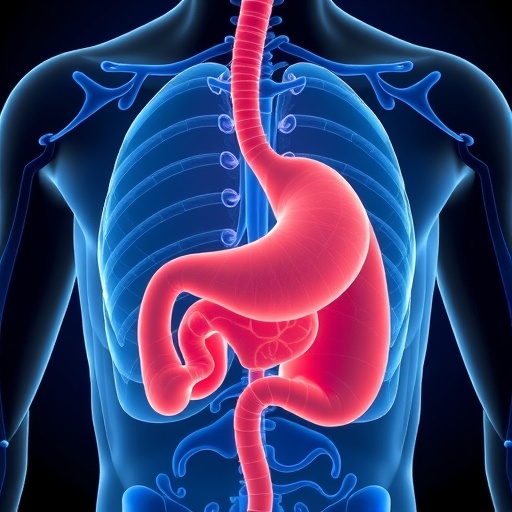In a groundbreaking study recently published in BMC Cancer, researchers have unveiled compelling evidence linking metabolic indices with survival outcomes in gastric cancer patients undergoing immunotherapy. This investigation, spearheaded by a team at Wuhan Union Hospital, delves deeply into the predictive potential of the lipid accumulation product (LAP) and visceral adiposity index (VAI), two sophisticated markers of metabolic health, highlighting their independent associations with enhanced long-term survival. The findings propel forward the nuanced understanding of obesity’s paradoxical role in cancer therapy, especially amidst the rising reliance on immune checkpoint inhibitors (ICIs).
Gastric cancer, notorious as one of the predominant causes of cancer-related death worldwide, continues to present significant clinical challenges despite advances in treatment. Immune checkpoint inhibitors, particularly those targeting the programmed death receptor-1 (PD-1) pathway, have emerged as a beacon of hope by reactivating the immune system against malignant cells. Nonetheless, patient responses are heterogeneous, underscoring an urgent need for reliable biomarkers that can more accurately stratify patients likely to benefit from such therapies.
Traditionally, obesity has been viewed with suspicion in oncology due to its well-documented links to cancer incidence and progression. Paradoxically, recent clinical observations have highlighted an “obesity paradox,” where individuals with obesity sometimes experience better outcomes after immunotherapy. This contradictory phenomenon has prompted researchers to seek metabolic measurements beyond the simplistic, and often insufficient, body mass index (BMI).
.adsslot_YfkDrbSviz{ width:728px !important; height:90px !important; }
@media (max-width:1199px) { .adsslot_YfkDrbSviz{ width:468px !important; height:60px !important; } }
@media (max-width:767px) { .adsslot_YfkDrbSviz{ width:320px !important; height:50px !important; } }
ADVERTISEMENT
The recent study propels this discourse further by focusing on LAP and VAI, both of which integrate anthropometric and biochemical data to yield a more comprehensive picture of visceral fat and metabolic status. LAP is calculated through waist circumference and triglyceride levels, while VAI incorporates additional parameters such as BMI and high-density lipoprotein cholesterol (HDL-C), with adjustments for sex-specific physiological differences. These indices together encapsulate the intricacies of metabolic-immune system crosstalk possibly missed by BMI alone.
The patient cohort’s survival was evaluated using progression-free survival (PFS) and overall survival (OS) metrics, crucial endpoints that reflect disease control and longevity, respectively. Remarkably, those bearing higher LAP and VAI scores showcased significantly improved PFS and OS rates. The survival benefit observed among these patients was not marginal but exhibited striking statistical strength, with log-rank tests showing p-values less than 0.001 for both indices.
To establish the robustness of these associations, the investigators employed multivariate Cox regression models that adjusted for potential confounders such as cancer stage and demographic factors. Results confirmed that high LAP and VAI were independent protective factors for survival outcomes, reducing hazard ratios by more than half for disease progression and mortality. Such distinct prognostic relevance underscores the utility of these indices as predictive tools in clinical decision-making frameworks.
Further reinforcing their predictive performance, the study utilized time-dependent receiver operating characteristic (ROC) curve analysis. This method evaluates the accuracy of prediction models over specified time intervals, and in this context, both LAP and VAI demonstrated compelling discriminatory power for forecasting survival in patients undergoing immunotherapy. Complementary decision curve analyses illustrated how integrating these metabolic indicators into clinical evaluation could substantially enhance patient benefit by guiding therapy choices.
The implications are profound. By capturing nuances of visceral adiposity and lipid metabolism, LAP and VAI may reflect underlying biological mechanisms that influence immune responsiveness. For instance, adipose tissue is known to secrete a host of adipokines and cytokines that modulate systemic inflammation and immune surveillance, potentially altering tumor microenvironments and affecting therapeutic efficacy. These metabolic factors may modulate T cell infiltration or checkpoint molecule expression, thereby increasing or diminishing immunotherapy responsiveness.
Importantly, this study transcends the limitations inherent in using BMI alone, which fails to differentiate fat distribution and metabolic quality—key determinants in the pathogenesis of cancer and treatment response. The ability of LAP and VAI to integrate biochemical profiles with anthropometric measures means they can serve as refined, patient-centric biomarkers that capture metabolic health’s multifaceted influence on immunotherapeutic success.
Moreover, the findings invite a conceptual shift towards incorporating metabolic profiling as routine in oncologic practice, especially in the era of precision medicine. By identifying gastric cancer patients likely to achieve durable benefit from PD-1 inhibitors through simple blood and waist measurements, clinicians might tailor treatment strategies to optimize outcomes while minimizing adverse effects and healthcare costs.
The growing appreciation of adiposity’s dualistic nature in cancer biology calls for further mechanistic investigations. Future research must elucidate how visceral fat and lipid metabolism intersect with immune checkpoints at the molecular level, potentially uncovering novel therapeutic targets or combinatorial interventions that harness the metabolic milieu to augment immunotherapy efficacy.
This study, with its robust methodology, comprehensive analytic techniques, and clinically pertinent conclusions, underscores how metabolic parameters can complement traditional staging and genomic profiling. Such multidimensional evaluation paves the way for personalized cancer care that is dynamically responsive to patient-specific physiological contexts beyond tumor-centric factors alone.
The timing of these insights is critical as immunotherapy indications expand and the oncology community grapples with variability in patient outcomes. Optimizing response prediction remains a paramount clinical challenge. By validating LAP and VAI as independent survival predictors in gastric cancer immunotherapy, this research delivers impactful tools that could reshape prognostication paradigms and support nuanced therapeutic decisions.
In sum, the uncovering of LAP and VAI as independent predictors of long-term survival offers a promising avenue to unlock the obesity paradox in cancer treatment. As metabolic health emerges as a pivotal determinant of immunotherapy success, clinicians and researchers alike stand to gain from integrating these metabolic indices into standard cancer care algorithms. This advancement enriches the growing armamentarium aiming to extend survival and enhance quality of life for gastric cancer patients worldwide.
Subject of Research: The prognostic significance of lipid accumulation product and visceral adiposity index in long-term survival prediction for gastric cancer patients undergoing PD-1 inhibitor immunotherapy.
Article Title: Lipid accumulation product and visceral adiposity index as independent predictors of long-term survival after gastric cancer immunotherapy.
Article References: Wang, Y., Li, Y., Guo, Y. et al. Lipid accumulation product and visceral adiposity index as independent predictors of long-term survival after gastric cancer immunotherapy. BMC Cancer 25, 1009 (2025). https://doi.org/10.1186/s12885-025-14411-6
Image Credits: Scienmag.com
DOI: https://doi.org/10.1186/s12885-025-14411-6
Tags: biomarkers for gastric cancer treatmentclinical challenges in gastric cancer managementgastric cancer survival predictorsimmune checkpoint inhibitors and survivalimmunotherapy in gastric cancer patientslipid accumulation product in cancerlong-term outcomes in gastric cancermetabolic health and cancer prognosismetabolic indices and cancer therapyobesity and cancer therapy responseobesity paradox in cancer treatmentvisceral adiposity index and immunotherapy





